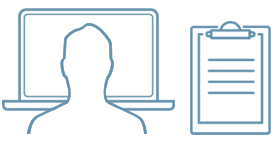
Usability testing
After creating personas during the user research phase, we developed the first prototype of Ronda, a simple carpooling platform that helps you find and share rides with nearby friends and colleagues.
To get a reliable evaluation of the prototype we started by conducting usability testing, which main purpose was to observe how users interact with the prototype while thinking out loud and doing some specific tasks provided by the facilitator who was guiding the participants and taking notes to harness user feedback in the best possible way.
We had only 20 participants, the half of them were using Ronda and the rest of them were testing a competitor’s platform. This competitive analysis was conducted to understand how the participants are using a competitor’s product and in that way we learn to identify what works and what doesn’t, helping us to capitalize things done well and avoiding potentially fatal mistakes.
The duration of the session was about 2 hours, we scheduled a first appointment only with the users of Ronda and one hour later in a second meeting we tested the competitor’s platform with the rest of the participants.
The facilitator started attending one user per test in one room while the rest of the assistants were waiting in a separate comfortable room enjoying the best pizza in town.
Unfortunately we didn’t have a traditional lab where tests are conducted (typically 2 rooms separated by a 2-way mirror for observation purposes) but that didn’t stop us from getting meaningful feedback.
We recruited participants who wanted to bring their own device with them (smartphone, tablet, laptop, etc). We found this important because if users could use their own computers and browsers they use on a daily basis we could get a true and accurate result from the user’s natural environment.
At the end of the session we shared our observations to the entire team and started a discussion about which were the problems to be fixed and what we were going to do to fix them, focusing ruthlessly on fixing the most serious problems first. To achieve this, we detected the top 3 usability problems we observed during the test session.
The top 3 usability problems we found
1- Every driver has a rating star system with comments provided by their passengers but when drivers have no rate, passengers have no way of knowing more about them while looking for a safe, reliable and comfortable ride.
2- The driver who is publishing the ride wants to know if the passenger will bring baggage with him and what is the size of it to see if there is enough space available in the car.
3- Just like passengers can see the rating of drivers, drivers would like to see the rating of passengers.
After conducting this usability test we considered the feedback to make decisions and product enhancements. With the top 3 problems fixed, we started planning a second round of usability testing with the purpose of testing early and often, catching problems while it’s still easy to fix them.
Solutions
1- We changed the login options of Ronda so users could only access with their facebook accounts, this way users could not only find rides but also view if they have mutual friends with drivers and easily ask references about them.
2- We included a new feature where passengers could easily select the size of their baggage.
3- We added a rating star system for passengers with comments provided by the drivers.
Takeaways
– The mission of the facilitator is being a thought catcher.
– Focus on finding the most important problems first.
– Test early and often, catching problems while it’s still easy to fix them.
